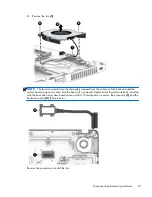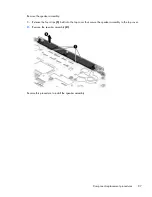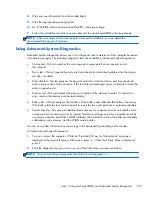
Using MultiBoot
About the boot device order
As the computer starts, the system attempts to boot from enabled devices. The MultiBoot utility, which is
enabled at the factory, controls the order in which the system selects a boot device. Boot devices can
include optical drives, diskette drives, a network interface card (NIC), hard drives, and USB devices.
Boot devices contain bootable media or files that the computer needs to start and operate properly.
NOTE:
Some boot devices must be enabled in Computer Setup before they can be included in the
boot order.
You can change the order in which the computer searches for a boot device by changing the boot
order in Computer Setup. You can also press
esc
while the “Press the ESC key for Startup Menu”
message is displayed at the bottom of the screen, and then press
f9
. Pressing
f9
displays a menu that
shows the current boot devices and allows you to select a boot device. Or, you can use MultiBoot
Express to set the computer to prompt you for a boot location each time the computer turns on
or restarts.
Choosing MultiBoot preferences
You can use MultiBoot in the following ways:
●
To set a new boot order that the computer uses each time it is turned on, by changing the boot
order in Computer Setup.
●
To dynamically choose the boot device, by pressing
esc
while the “Press the ESC key for Startup
Menu” message is displayed at the bottom of the screen, and then pressing
f9
to enter the Boot
Device Options menu.
●
To use MultiBoot Express to set variable boot orders. This feature prompts you for a boot device
each time the computer is turned on or restarted.
Setting a new boot order in Computer Setup
To start Computer Setup and set a boot device order that the computer uses each time it is turned on or
restarted, follow these steps:
1.
Turn on or restart the computer, and then press
esc
while the “Press the ESC key for Startup Menu”
message is displayed at the bottom of the screen.
2.
Press
f10
to enter Computer Setup.
3.
Use a pointing device or the arrow keys to select
Advanced > Boot Options > UEFI Boot
Order for UEFI Hybrid or UEFI Native Boot Mode, or select Advanced > Boot
Options > Legacy Boot Order for Legacy Boot Mode
, and then press
enter
.
4.
To move the device up in the boot order, use a pointing device to click the up arrow, or
press the
+
key.
– or –
94
Chapter 7 Computer Setup (BIOS)
Summary of Contents for EliteBook 820 G1
Page 4: ...iv Safety warning notice ...
Page 26: ...Computer major components 18 Chapter 3 Illustrated parts catalog ...
Page 146: ......
















































